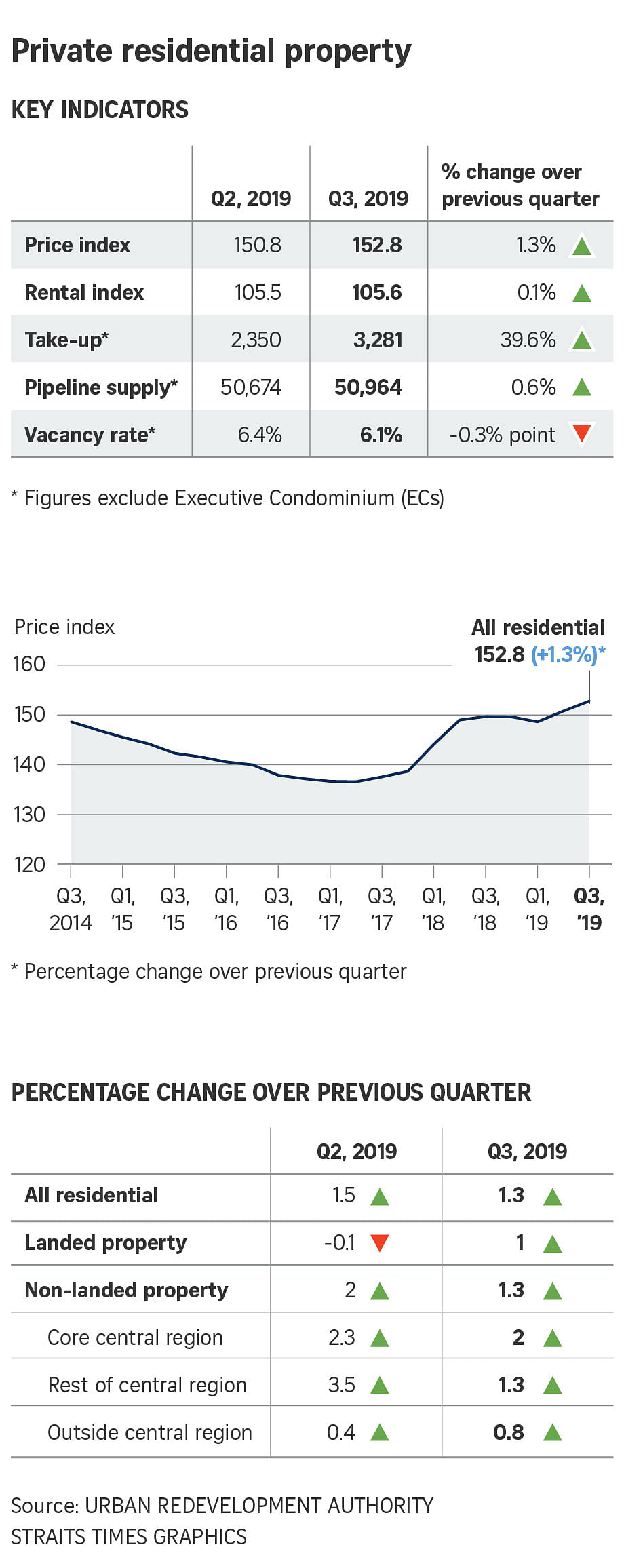SINGAPORE - Third-quarter private home prices rose 1.3 per cent over the previous three months, more than the 0.9 per cent gain previously estimated by the Urban Redevelopment Authority (URA), underpinned by higher prices of new launches and demand for properties in the prime and city fringe districts.
Private home prices extended gains for a second straight quarter, following a 1.5 per cent gain in the second quarter, led by growth in the high-end segments. Prices of non-landed properties in the prime districts - known as the core central region (CCR) - were up 2 per cent in Q3, versus a 2.3 per cent gain in the previous quarter.
Prices of non-landed homes in the city fringe or the rest of central region (RCR) rose 1.3 per cent, in comparison to a 3.5 per cent gain in the previous quarter, due to launches such as One Pearl Bank and Avenue South Residence, Mr Desmond Sim, CBRE head of research, South-east Asia, said.
Meanwhile, prices of non-landed properties in the suburbs or outside the central region (OCR) edged up 0.8 per cent, after a 0.4 per cent increase in the previous quarter.
The improvement in overall third quarter prices are also due to prices of landed properties jumping by 1 per cent in the third quarter, compared to a 0.1 per cent dip in the previous quarter, Huttons Asia director of research Lee Sze Teck noted.
Despite the weaker macro-economic environment, Mr Sim expects home prices to show moderate growth for the rest of the year, due to the ramp-up in project launches where new sales are likely to continue driving up the psf price.
Developers sold 3,281 homes in the third quarter - the highest number of new homes sold in a single quarter since Q2 2013 (4,538 units), Ms Christine Sun, head of research and consultancy at OrangeTee & Tie noted. That's 39.6 per cent more than the 2,350 units booked in the previous quarter.
The number of non-landed homes being sold in RCR and OCR have increased substantially last quarter. New sales in RCR increased 32.7 per cent from 1,162 units in Q2 2019 to 1,542 units in Q3 2019 while the number of new sales in OCR rose 53.5 percent from 1,018 units to 1,563 units over the same period.
PropNex Realty chief executive officer Ismail Gafoor believes that the new sales segment will continue to outperform, likely reaching 10,000 new sales in 2020.
The higher sales volume in 3Q is likely a result of flight to safety amid macro-economic uncertainty, Mr Lee said.
He noted that the number of foreign buyers buying units in new launches jumped almost 80 per cent in the third quarter.
"The stability of the country and currency are probably key reasons why foreigners chose to invest in Singapore. There was also a sharp spike of more than 50 per cent in the number of Singaporeans buying new launches as well, he added.

Developers launched 3,628 uncompleted private homes (excluding executive condominiums or ECs) for sale, more than the 2,502 units launched in Q2. CBRE expects the ramp-up to continue, as there are close to 15 new projects launching next quarter.
A total of 11 projects were launched in 3Q including Dunearn 386, Haus on Handy, Jervois Treasures, One Pearl Bank, View at Kismis, Parc Clematis, Cuscaden Reserve, Meyer Mansion, The Antares, Uptown @ Farrer and Avenue South Residence.
For ECs, developers launched 820 units for sale in the third quarter this year, and sold 426 units. In comparison, developers did not launch any EC units and sold 10 EC units in the second quarter.
Despite the continued improvement in prices, some analysts downplayed risks of a housing bubble forming, citing the slower pace of price gains in the third quarter and low sub-sale activities - an indicator of speculative demand.
The cumulative price growth for the first three quarters of this year is 2.1 per cent, which is much slower than the 7.9 per cent increase over the same period in 2018, Ms Christine Sun, head of research and consultancy at OrangeTee & Tie, noted. She cited safeguards such as the TDSR (total debt servicing ratio), a cool-off in collective sales and more measured land bids.
"Sub-sale activities are still at a low: constituting around 1.8 per cent of total sales compared with 11.6 per cent in Q4 2009, prior to the implementation of Seller Stamp Duties in February 2010," Ms Sun said.
There were fewer resale homes sold in Q3 - 2,378 versus 2,371 in the previous quarter. Resales also accounted for a smaller percentage of total sales - 41.3 per cent versus 49.7 per cent in the second quarter.
As at the end of the third quarter, there was a total supply of 50,964 uncompleted private homes (excluding ECs) in the pipeline with planning approvals. As at the end of Q3, unsold inventory remained high at 31,948 units (excluding ECs), despite easing off from 33,673 units in the previous quarter, Mr Sim said.
URA data also showed that rents of private homes inched up 0.1 per cent in the third quarter, after a 1.3 per cent rise in the previous quarter. Meanwhile, the vacancy rate edged down 0.3 percentage point to 6.1 per cent from 6.4 per cent.
Ms Sun attributed the improving leasing market to more expats being redeployed to Singapore lately.
"Thousands of multinational companies have set up regional offices in the Asia Pacific, and Singapore may now be taking the lead as a key business hub in Asia in view of the rising tensions in Hong Kong. Companies with footholds in Singapore and Hong Kong may shift their main operations here given that Singapore is also a strategic gateway to many global markets," she said.


